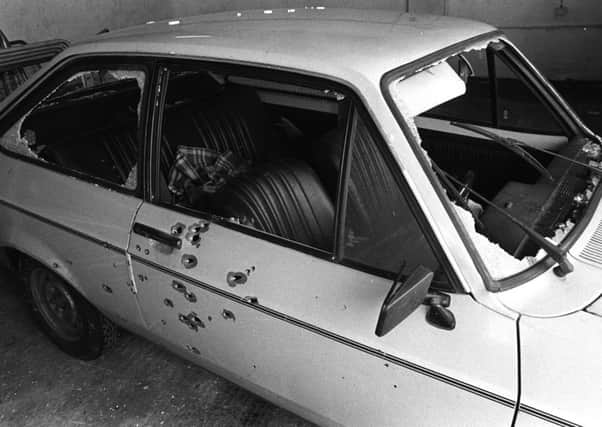Police chief to face coroner’s court over controversial inquests


PSNI Assistant Chief Constable Drew Harris will give evidence at a preliminary inquest hearing in Belfast later this month.
The logistics of Mr Harris’s appearance were agreed between senior coroner John Leckey and legal representatives at a hearing in the city this morning (Thursday).
Advertisement
Hide AdAdvertisement
Hide AdThe officer is due to take the stand at the Royal Courts of Justice for around four hours on Monday, September 22.
Mr Leckey has repeatedly expressed concern at the length of time it is taking to hand over state files related to nine deaths in the early 1980s linked to the shoot-to-kill allegations.
The disclosure process has been running for seven years.
The inquests are among almost 50 outstanding legacy cases still to be dealt with by the Coroner’s Service.
Disclosure of police, army and other state agency files have been a recurring cause of delay in many of the probes including the nine deaths connected to the shoot-to-kill claims.
Advertisement
Hide AdAdvertisement
Hide AdThe requirement to security vet top-secret investigations into the killings by Greater Manchester Police Deputy Chief Constable John Stalker and Sir Colin Sampson of the West Yorkshire Police has been blamed.
The investigations by the two police chiefs were carried out in the 1980s but never published.
The PSNI is currently working to complete disclosure by Christmas.
The cases involve six people, including IRA men and a Catholic teenager, who were shot dead by the security forces around Lurgan and Armagh in 1982 amid claims there was a deliberate intention to kill them.
Advertisement
Hide AdAdvertisement
Hide AdThe coroner is also examining the deaths of three Royal Ulster Constabulary (RUC) officers who died in a bomb blast in Lurgan weeks earlier, an attack allegedly carried out by the IRA men who were subsequently gunned down - and therefore seen as a potential motivation for the claimed shoot-to-kill policy.
There have been repeated delays into the holding of inquests into the IRA killing of three policemen and subsequent RUC shooting of six men in Co Armagh in 1982.
RUC men Sean Quinn, Alan McCloy and Paul Hamilton were killed by an IRA landmine near Lurgan in October 1982.
Within weeks Gervaise McKerr, Sean Burns, Eugene Toman, Seamus Grew, Roddy Carroll and 17 year-old Michael Tighe were shot dead by the RUC’s Special Support Unit (SSU) in a series of controversial shootings in Co Armagh during a three week period.
Advertisement
Hide AdAdvertisement
Hide AdAll but Michael Tighe were members of republican paramilitary organisations; however none were armed at the time they were shot.
Counsel to the coroner Frank O’Donoghue QC explained why Mr Harris had been called to give evidence.
“The purpose of this is to identify where blockages and impasses are happening so we do get this finished by Christmas,” he said.
Mr O’Donoghue said written statements already passed to the coroner by the PSNI indicated that Mr Harris may not be able to answer all the questions related to the disclosure process.
Advertisement
Hide AdAdvertisement
Hide Ad“That raises the possibility that another witness from the police may need to be called,” he said.
The lawyer said there would be a need to “take stock” after Mr Harris’s appearance to decide if another witness should be called.
Earlier this summer Mr Leckey warned that the inquests may not be able to proceed if there is insufficient disclosure of state files.
In a strongly worded letter to Northern Ireland Secretary Theresa Villiers he warned the Government that continuing failure to adequately resource inquests into historic Troubles killings could leave it in breach of international law.